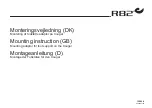
6
www.myamigo.com
Assuring Long Battery Life & Warranty Protection
Establish a regular procedure for charging a fleet of Escorts to assure all are fully charged. A multiple outlet strip with a “POWER ON”
indicator light could be used. Do not exceed outlet rating. Chargers draw approximately 2 amps each.
Be sure that all charging outlets are protected by a minimum 15-amp ground-fault circuit interrupter (G.F.C.I.).
Batteries are rated to last up to 400 full discharge/recharge cycles, which converts up to 400 days of charging (if the above procedures
are followed.)
If the Escort slows down and eventually loses all power within a day’s use – and all other systems appear to be functioning normally
– the batteries may need replacing. In the event of assumed battery failure and if the Escort is still under warranty, you may wish to
replace the batteries to prevent any lengthy downtime. After removing batteries, have a qualified Amigo Service Technician load test
them. If the batteries check bad, you may call the factory direct to order a replacement and verify warranty status. If they check good
another problem exists. (Refer to diagnostic codes on page 9.)
Charging Precautions
• Charge batteries fully in a dry location.
• Clean any corrosion on the plug.
• Examine cord periodically for cracking or damage.
• If you remove the batteries from the Escort, place them on a surface resistant to damage by acid fumes. “Breathing” occurs
whenever a battery is charged and discharged through a cycle. This breathing of batteries emits acid fumes and may mark
surfaces they rest on for long periods of time.
• Each time you charge the unit, follow the charging instructions exactly. Working in the vicinity of a sealed lead acid battery can
be dangerous. Batteries can generate explosive gases during normal battery operation.
• Never smoke or allow an open flame in the vicinity of the batteries.
• Use only a charger designed for sealed lead acid batteries. The charger is not intended to supply power to an extra-low voltage
electrical system or to charge dry cell batteries.
• Never charge a frozen battery.
• Do not operate the charger in a closed-in area or restrict ventilation in any way.
• A spark near the battery may cause an explosion.
To reduce the risk of spark:
• Prevent external damage to AC and DC cords.
• Connect DC charging cord to the charge plug before connecting charger AC supply cord to the AC electrical outlet.
• When disconnecting the charger, always do so in reverse sequence of connecting procedure. Break first connection as
far away from battery as practical. Distance reduces the chance of explosion if a spark is generated and gas is present.
• Someone should be within range of your voice or close enough to come to your aid, if needed.
• Be extra cautious not to drop a metal tool onto the batteries.
• Remove metal jewelry before servicing batteries.
TO AVOID DAMAGE TO BATTERIES DURING STORAGE, DO NOT PLACE THEM END TO END WITH THE POSITIVE (+) AND
NEGATIVE (-) TERMINALS NEXT TO EACH OTHER.
FAILURE TO FOLLOW THESE SAFETY INSTRUCTIONS MAY RESULT IN PERSONAL INJURY OR PROPERTY DAMAGE.
Figure 7


































